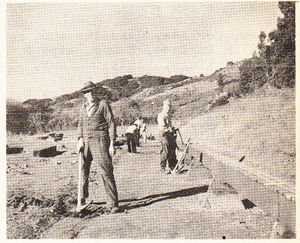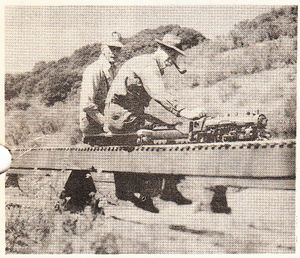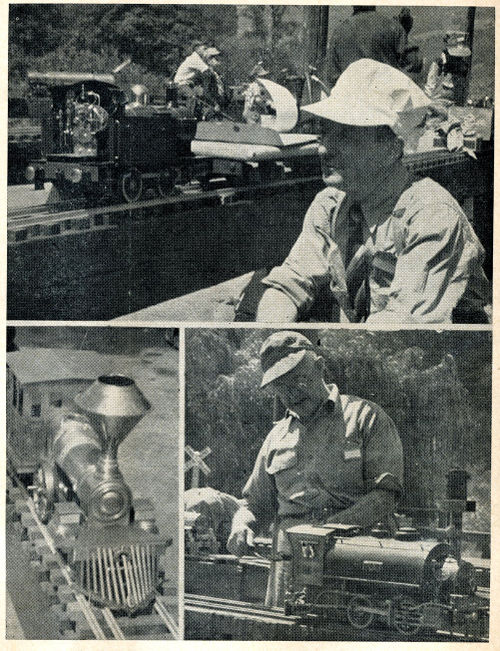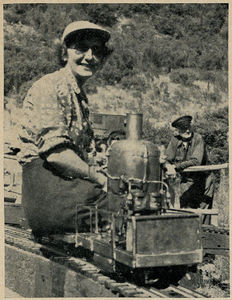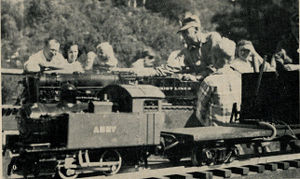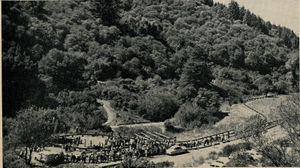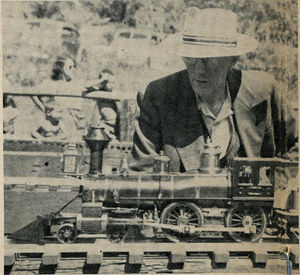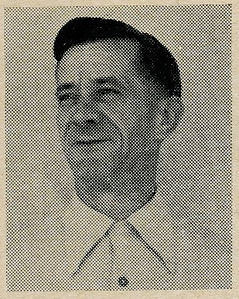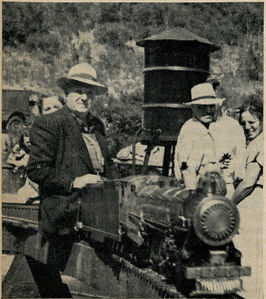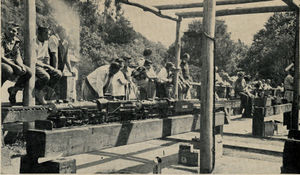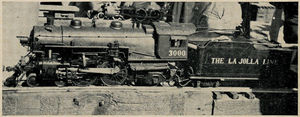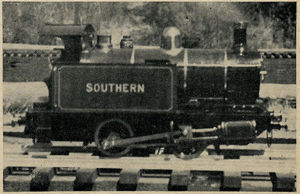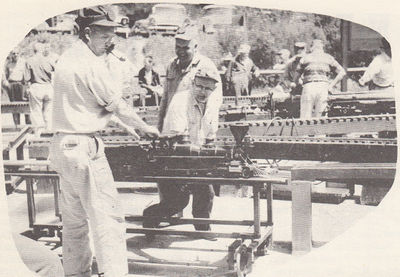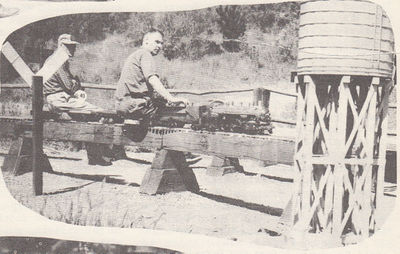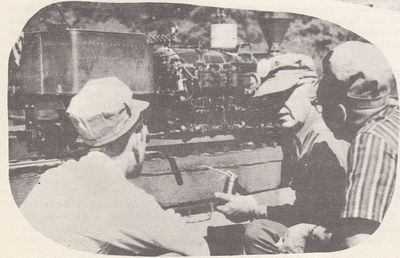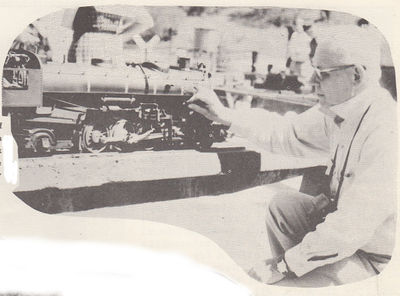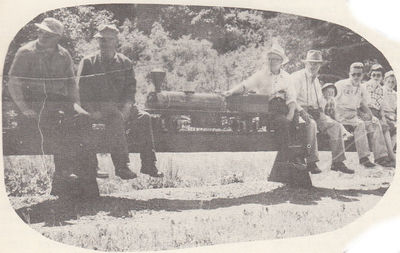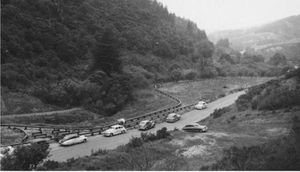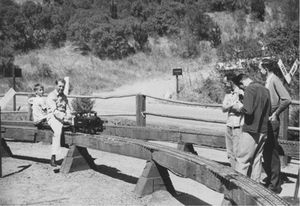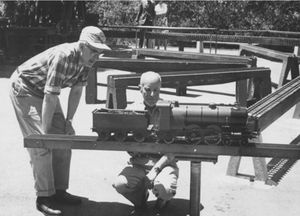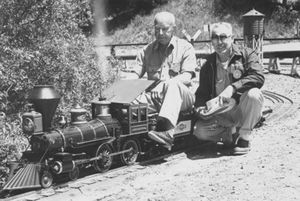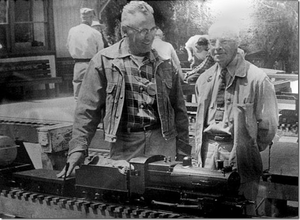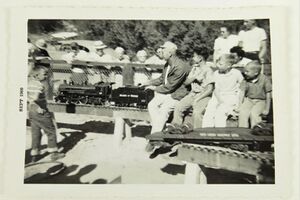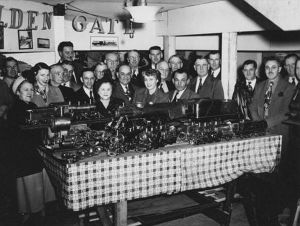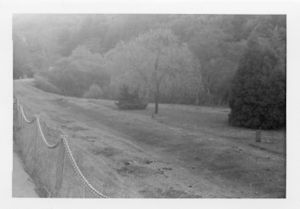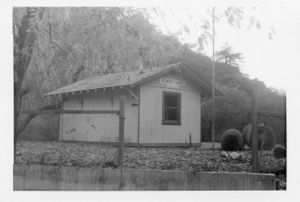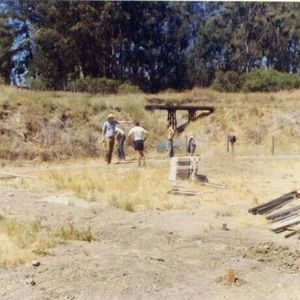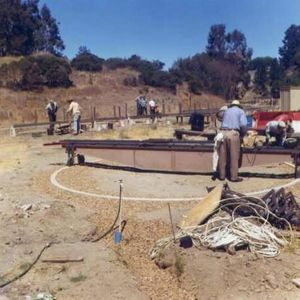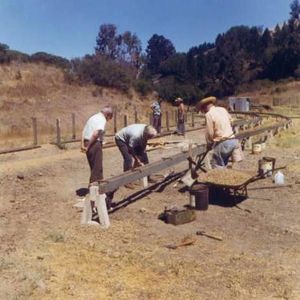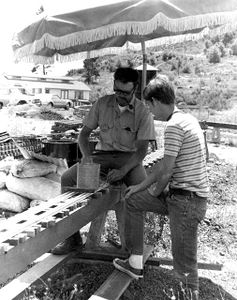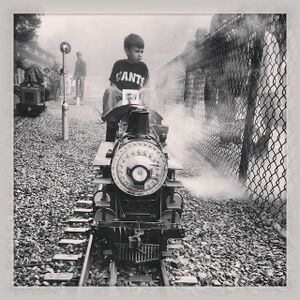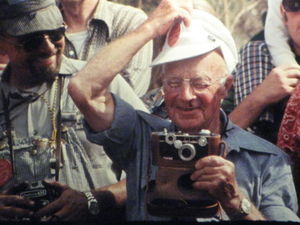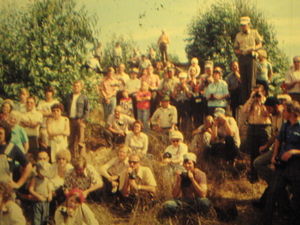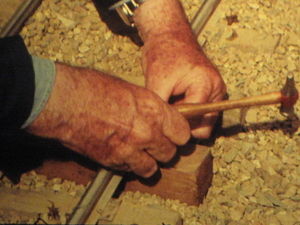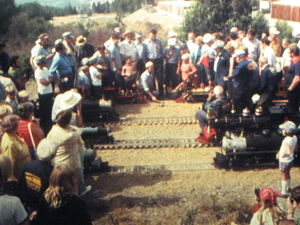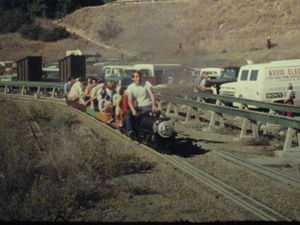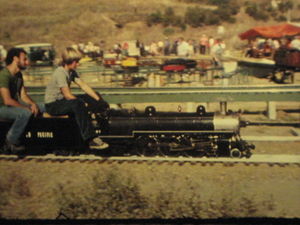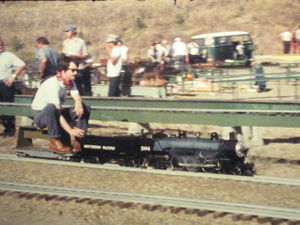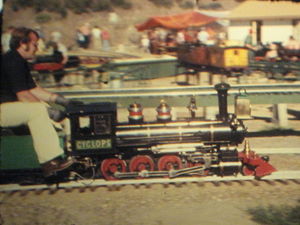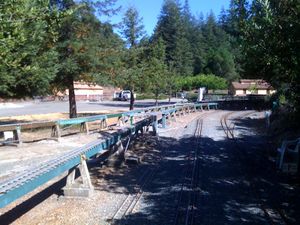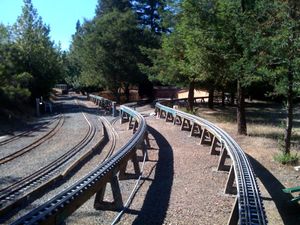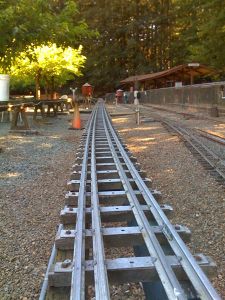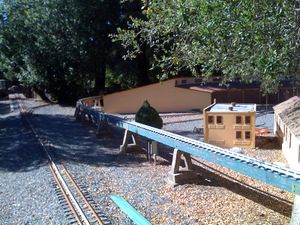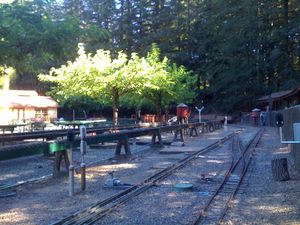Golden Gate Live Steamers
The Golden Gate Live Steamers is a club based in the Oakland/San Francisco area which promotes the live steam hobby. It is the oldest such club in the United States, having been formed in 1936 by Victor Shattock, though at that time the club had no outdoor track and steam operations were confined to the basement of Shattock's home in Oakland, California. The first GGLS outdoor track was built after 1940 at club member Loren Thacker's home in Stockton, California.
History
- “VIC SHATTOCK HISTORY TALK”
- Presented to members of the Golden Gate Live Steamers
- Regular Monthly Meeting
- Laurel Elementary School Auditorium
- Oakland, CA
- circa 1960
The Golden Gate Live Steamers started in the basement of our home. You might wonder why in the basement ? Well, going further back, like all boys I was fascinated by steam railroads so much that I was determined to build a railroad of my own.
I had a number of railroads long before I built the one in my basement, and during WWI, I built a 2-foot gauge railroad in France. It became a regular target of the Germans thus making it very uncomfortable for us. So I got all this railroad work.
After the war, I came down from Canada and went to work for the Southern Pacific. Later, we built a railroad at U.C.-Davis for their big Spring Festival one April. They arranged through my employer, S.P., to go there. Their carpenters would build the runway, I’d lay the track and we would run the trains. They estimated that over 10,000 people saw the operating exhibit. So much for my accomplishments.
Every time we moved I looked around the house for a place to establish a railroad. Finally, in 1934, we found a nice house with a large basement some 32 x 45 feet in size. Ideal, as there was nothing else in the basement except for the furnace and laundry tubs. For the next five years we were requested so many times to display our trains or put them where people could ride them. So many were attracted to that basement that after several demonstrations, many got the yen to build their own locomotives. A number of them did !
The track ran all the way around the basement with two or three sets of rails and a turntable near the furnace. There was a model of a 110-foot electrically operated turntable. Being no electrician, I got a couple of my sons to help me in that direction. There was a double slip switch in the Yard area. At the time, I had three or four engines. The water tank was near the turntable which I also used as a firing up track. A blower fastened to the stack of the locomotive sent the fumes up the chimney. First thing we did was to have a test run as soon as the first engine was fired up, then we would hook up a freight train and let it take off. Sometimes a single engine and sometimes a double-header. The track was in the basement for some twenty-seven years when the property was sold and the house had to be torn down. I sold the track to someone who is still using it now. He said it went together perfectly. We had a lot of visitors to the track, some curious and some downright interested in the “hows and wherefores” of building them and locating raw materials. Naturally, they thought that kits might be available. The press was attracted to this new thing, running live steam engines in the basement of a house. Editors were fascinated and the concept of scenic steam trains in the basement of a house prompted them to write it up. From all this publicity we got many visitors, and the most frequently asked question was: “How do you get started?” “Where do you get your kits?” Two or three of us then and there decided to start a club and get the information to everyone.
This changed our concept from a scenic indoor railroad to an operating outdoor railroad. We wanted to get some land to operate on and ride our engines. We catered to influential people whenever possible. We put on a show in the Auditorium and for the Southern Pacific and the Yardmaster’s Association who wanted something unusual. It was put on at 74th Avenue for the Storekeepers there. Moving benches, we built an 80-foot long track and had an engine running up and down hauling children. They queued up all the way around the block. Member Larry Duggan wore himself out lifting kids on the riding car. This had its benefits in publicity and we developed many friends which paid off later. Eventually, we heard of a piece of land in Redwood Park. We went to look at it and it was necessary to cut away the “bullrushes” so we could lay stakes for the surveyors. I don’t remember when the yard dirt was put in but some may recall the Boy’s Clubhouse there where the steaming bays near the parking lot we use now.
Before stakes could be driven there was a tremendous amount of work that needed to be done. We had about eighteen hardy members and we would all go up and carve the weeds away until the ground was ready to use. Next operation was to fill the ground and then survey. We still had influence with the Southern Pacific who took care of that chore. Twenty-six of them, all bosses—twenty-six of them and they were all made Honorary Members of GGLS. Mr. McKinney, present here tonight, can probably remember the start, I guess. “Somebody told the SP Roadmaster, ‘here,give’em a few ties----“ . When we had the basement club the dues were ten cents a month, mostly for coffee and donuts which didn’t leave much of a kitty when we had Redwood available to us. Often in the red, so we decided to raise the dues to $ 1.00 per month, or the same as now, $ 10.00 per year. So, here we are, with land in terrible shape, and we needed money to get materials. With only eighteen members ! We turned to the basement again and it served us well. We got donations when they found we had the project going--- several threw in $ 10.00 “to help you folks out” and so on.
After entertaining some Scouts from Crockett one night, the lady in charge of them later sent us a check for $ 120.00 to help us build. Then different ones made loans because we needed cash for rails which were very expensive. Being faced with the problem of spending all the money on rails, which looked like it was necessary, we called a meeting in the basement. We got S.P. officials down there along with officials of Redwood Park. We put on a show with engines all over the place. It showed the officials what we were doing. We felt that we were advertising railroads anyway and if we could get their help, our troubles were over. Regarding those meetings, a lot of them took place during the War; not only various officials, but also the police. I don’t know why, but maybe the number of cars parked in front of the house aroused suspicion. “Wonder what all those cars are doing there?” Maybe subversive activities! Anyway, they were there. One early arriver introduced himself and said he wanted to know what we were doing there.. I invited him in and to stay for the meeting. He said he’d like that and it was not until then that he told me he was with the police department. I don’t recall if he left a donation or not, but it didn’t make any difference.
Well, we had the meeting, showing how worthy the work was that we were doing, and that it deserved their support and that any help they could give we’d be glad to have. The result was we got engineers to make contour maps, stake out the railroad, everything, so all they had to do was give it to the engineer of the Park District so those people could fill exactly to where the stakes had been driven. It was a great help, and we would up with a lovely flat piece of land. There were objections, of course, especially from the Horseman’s Association. “Why should we have all this level property?” Several complaints like that, but we had to prove ourselves. So we had meetings with discussions and decisions regarding the track and type. Most of the fellows wanted an elevated track so you could sit on a car and drive your engine. And where would we get the lumber ? I mentioned that the SP Roadmaster gave Mac McKinney and another fellow some ties. It was impossible to put anything down like that—we’d never get it done in ten years. So one day I went to the Roadmaster and asked if he could let us have about 150 ties. Good ones, not new, but usable ones. He said, “You’ve got your nerve”. There’s dozens of customers who want them badly and we won’t even give or sell to them…… I told him I wasn’t interested in their customers, that we were only interested in getting 150 ties. Then he said, “Where are we going to get 150 ties?” I told him GGLS has spies out and they have a lot of friends. SP is tearing up a “ballast deck trestle” at Cordelia and there is a boxcar in the Yard with over 200. “Where did you get that?” It makes no difference— You have the ties and we want them. “Are you going to need that many?” Yes, we will! He didn’t ask how we were going to get them to Redwood Park, but I was a foreman with two trucks at my disposal so I had them back a truck to the door of the boxcar and rolled them off. I think, too, that the Live Steamers were surprised when they arrived at Redwood one Sunday and saw that had been done. You see, we had to make piers to put the ties on.
It was finally decided to get lumber cut that way(demonstration at this point, in front of the membership, as to how lumber will be cut and placed) it would be fine for supporting the ties. Lots of lumber was kicking around the SP in various places that was 7 ½” x 17’ and 24’ … We took the lumber to a mill who wore out five band saw blades because of the sand and grit in the lumber. So we got plenty of piers and one day sent a truck with a gang to place them but I’m a little ahead of my story, as we had already laid out a 60’ circle, so it looked like we were going to have to be satisfied with that. Meanwhile, the “brain trust”, Harry Dixon as Secretary, Tim Reardon, Vice-President and I (Vic) as President, not being Satisfied with the layout as it was, started working on options, so one day we went to the park and tore up the whole circle. I might say that the Park people were not as sympathetic as they are with you folks today. They thought we were just a bunch of crazy nuts anyway. I guess they thought if it doesn’t work out, the land can be used for baseball or something.
After building toward the upper end, the fellows were getting sort of tired, but there was another thing about the ties. They were not exactly square! They had a twist in them, so it was necessary to get them flattened out. After using all sorts of tools, planes and adzes, etc., an SP man came along and said we could have a “planer” if we’d like. So we arranged for the power! We had all sorts of electric tools. Very little pick and shovel work was done. The ground there was hard as concrete. SP furnished the supplies and we got them all the way around. Next was ties for the rails. I do not know how many thousand there were (ed: 7500) but we got the Bridge & Building people at SP to cut them for us from pure Redwood. Band them, package them and deliver them to Redwood Park. So then there was the question of –all our money was gone for rail—so we were probably in debt. We needed nails to bind it all together. Good old SP had a kind heart ! I remember when we opened the track officially that one fellow told the SP Asst.General Manager (Mr.E.D.Moody) that “there’s more SP stuff here than you’d expect to find here, isn’t there?” “Oh no”, he said. “We knew you were getting it!” But we used to take everything we wanted. We put in a Transfer Table, water tank, angle iron and all that stuff all made in the SP shop at West Oakland.
Next we had to justify to the Park that they had done the right thing in letting us use the property. Only two or three of us had engines, and you’ll see a picture of one of my engines pulling a string of cars. This showed the public that there was activity going on. I believe there is a picture showing a 3 ½” gauge engine as finished. Harry Dixon took that picture. We were up and it was cold that day. Speaking of weather, when we officially opened it was as hot as hades. We just melted. Well, as time passed the track began to get used. I feel pretty sure everyone enjoyed the work that was progressing. There were not many of us, but we worked hard. Then, there was this General Manager, Dick Walpole. He wanted a log house put up for a station. So we drew up something that looked like a log house for a station. That’s how he wanted it, to conform to the rest of the Park. We dug holes, put up poles, you ought to have seen it. There are pictures. We knew it wasn’t coming to anything and were glad when it came down. There was a new Administration who let us remove it. It was an eyesore, anyway ! So there is not much to add to the basement story except many wanted to know how to start engines, so the basement meetings in my home became like ‘school’, which most of the fellows that were there wanted. When they ‘graduated’ I don’t know if they got diplomas or not, anyway it got publicity and people building engines. They got pointers and information that served them well and would not have gotten otherwise.
For my own part, I believe I got most of my information from “LBSC” articles in England. (L.Lawrence) … I read every book on this subject that I came across, and that was way back, even before LBSC’s writings. I had enough from those books so I could impart a little information that the fellows could follow. I think therefore, that the basement meetings helped a lot of them get started in the right direction. The “Live Steamers”, in 1940, went to Stockton where one of the boys had moved and, since he decided to build a track in his back garden, we helped him by putting down the rail. We used square key stock. We drilled holes and put finishing nails down through it. I wanted to take this opportunity to thank you for your interest in the birth of the Golden Gate Live Steamers. It isn’t all that we could tell you because the time from 1936 to the present would take more than a half hour to tell. One thing I’d like to say, that the track has been developed and improved so well it serves as a commendable compliment to the members and officers who had anything to do with it. Further, I congratulate them and am proud to have had a part in it and had so much a hand in starting it. It makes me feel grateful to know that it has grown as much as it has. Our finances used to be three or four dollars, now you have several thousand. Our membership was eighteen, now you have some 150 odd. There’s a lot that canbe done with enthusiasm and muscle, of course, to make it really worth while. As Harry Dixon said at the beginning of this presentation, “one of the largest Live Steam clubs in the World” . And that’s something to be proud of ! Thank you for your attention ……
(Presentation given by Victor T. Shattock --- circa 1960 ……)
Re-copied from audio tape by Kenneth V. Shattock ……(January 20, 2008)
1950
The Live Steamer, July-August 1950
This fine group of live-steam enthusiasts have been very busy in past months building a new steam track. Mr. Victor Shattock and Larry Duggan have sent in a description of the new track, which was recently completed enough to operate on the 2-1/2 inch and 3-1/2 inch gauge. This track is located in Redwood Park, Oakland, California and is built of heavy trestle roadbed on actual ties furnished, I understand, by the Southern Pacific Railroad. It is a multi-gauge track laid in a loop 1330 feet in total length to accommodate 2-1/2 inch, 3-1/2 inch and 4-3/4 inch gauge locomotives. The minimum curve radius is thirty food radius, and the maximum is eighty three foot radius, speed boards being placed at certain curves. All the facilities for operating and servicing engines are being installed. The operating rules are based mainly on rules laid down by New England Live Steamers, most important being the requirement of boiler and safety valve tests. The Official Opening of this new track has been set for the dates September 2, 3 and 4th, and all members and brother live-steamers are cordially invited for this Opening Meet and spike driving ceremony which is to take place a 2pm Daylight Saving Time, on Saturday September 2nd. Movie cameras will record the parade of locomotives for this Official Opening ceremony. Reminders of this date and a "How to get there map" will be mailed to as many friends as possible. Further information and details of this occasion may be obtained from either President V.T. Shattock, 1877 38th Ave, Oakland, or the Secretary H.L. Dixon, 1182 Russell Way, Hayward, California. At a later date Vic Shattock has promised to send along a history of the building of this track, with its constructional details which we will be glad to receive for mention in future issue of Live-Steamer. Carl Purinton, our New England Brotherhood Secretary had the honor of being the first visiting live-steamer to run an engine on the new track while on a trip to the West Coast. Vic Shattock was the first to make a test run with his 2-1/2 inch and 3-1/2 inch gauge locos.
The photos below will give the readers an idea of the setting of this California track. Men in the "road gang" photo were Tim Riordan and L. McKenney taken while working on the roadbed December 1949. Other photo shows Vic Shattock and Scotty Gordon running Vic's 2-1/2 inch gauge "Mike" on a section of the track in April 1950.
Redwood Park Golden Spike
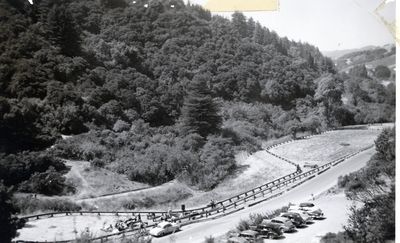
The Live Steamer, November-December 1950
The multi-gauge track constructed by the Golden Gate Live Steamers in the Redwood Regional Parker, Oakland, California, was officially opened on September 2, 1950. The golden spike, formally completing the loop, was driven Mr. E.D. Moody, Assistant General Manager of the Southern Pacific Company, and Mr. John MacDonald, Director of the East Bay Regional Park District. The ribbon stretched across the track was cut by Mrs. Irene Evans, daughter of President Victor Shattock of the G.G.L.S. thereby removing the only barrier to the dozen steam locomotives lined up ready to pass and reviewing stand. The parade was led by Jim Keith's 1 inch scale 4-6-4 with Jim's son Sid at the throttle, followed by members of the Southern California Live Steamers and the San Diego Live Steamers, with one or two engines from the home gang.
Visiting live steamers, with and without engines, are listed, the locos being placed under steam at one time or another during the three day meet:
- Jim Keith, Riverside CA, 4-3/4 inch gauge 4-6-4 SCLS
- Gordon Corwin, Los Angeles, CA, 3-1/2 inch gauge 4-8-4, President SCLS
- Philip West, North Hollywood, CA, 3-1/2 inch gauge 4-6-0 SCLS
- Gene Paul, Inglewood, CA, 4-3/4 inch gauge 0-4-0 SCLS
- Mark Piper, Los Angeles, CA, 1-1/2 inch scale Minneapolis Tractor
- Charles A. Cole, Ventura, CA, no engine
- R.V. Cuttell, La Jolla, CA, 3-1/2 inch gauge 4-4-2, SDLS
- W.V. Hill, La Jolla, CA, 3-1/2 inch gauge, 4-6-6, SDLS
- A.S. Chapman, San Diego, CA, no engine
- Arthur Anderson, San Rafael, 3-1/2 inch gauge 4-6-2, no affiliation
- John Mathews, Chicago, IL, 2-1/2 inch Rocket
- Joe Hild, New Jersey, no engine, Eastern Live Steamers
- Doc Fixit, Junction City, OR, no engine
- Franklin Ryder, Albany, OR, no engine
Golden Gate Live Steamers members ran engines as follows:
- Winton Brown, Danville, CA, 3-1/2 inch gauge 4-8-4
- Walter Brown, Oakland, CA, 2-1/2 inch gauge 4-4-0, 4-3/4 inch gauge 0-6-0
- Harry Dixon, Hayward, CA, 3-1/2 inch gauge 0-4-2 sidetank
- Ronald J. Shattock, Oakland, CA, 2-1/2 inch 2-8-2
- Harold Kubicek, Suisan Air Base, 3-1/2 inch 4-6-6
- Ed Mueller, San Francisco, CA, 4-3/4 inch 0-4-0
- Victor Shattock, Oakland, CA, 3-1/2 inch 0-4-2 sidetank
It should be mentioned that John Mathew's Rocket was not placed under steam. However, in order that everyone present might have an opportunity to observe the wonderful work in this little model, it was towed around the track layout in back of the Southern Pacific 2-8-2, with John riding on the car ahead.
The big engines of Jim Keith and Gordon Corwin, really got a workout over the three days of the meet, kept their engines going most of the time. They had not failures and are to be congratulated on the fine mechanical condition of their locomotives. Included in this category, are the Dan Diego boys R.V. Cuttell and W.V. Hill who stayed the one day only. This is no reflection on Phil West who had lubricator trouble once in a while and had to remove his loco from the mainline, as otherwise he did fine.
Once incident marred the smooth running of the railroad on the third day of the meet. Tim Reardon, Vice President of the Golden Gate Live Steamers was at the throttle of Gordon Corwin's 4-8-4. The Southern California Live Steamers operate their machines by sitting on the tender with the feet resting on stirrups fastened to the frame just under the firebox, due no doubt to the fact that their home tracks are laid on the ground. This driving position looks, and undoubtedly is, somewhat precarious when the engine is running on tracks elevated two feet or more above the ground and balancing is not so easy. However, whatever may have been the cause, after rounding one of the curves, the engine appeared to lift at the front end and rolled off onto the ground with Tim on top of it. Other than a light bruise or so, Time was unhurt which was fortunate, as it takes very little imagination to realize that the fall could have had serious results. The locomotive was permitted to lie as it had fallen until numerous pictures had been taken, after which it was loaded on Jim Keith's passenger cars and hauled back to the firing up tracks. Here Gordon checked the damage and other than a few bent brake rods and twisted piping, there appeared to be no reason why it could not be fired up and run again, which is exactly what was done and proved to all and sundry that a steam locomotive can take a flying leap and keep on going if you will give her a helping hand to get back on the track.
As for our home gang's engines; Walter Brown's 1 inch scale Southern Pacific switch engine made its first appearance and its first run on rails under steam. It is a beautiful piece of work and it performed just about the way it was expected to. It uses a minimum of fire and water and handles its loads with little or no apparent effort. Walter is to be congratulated on his handiwork and its results. Our genial secretary Harry Dixon had lubricator trouble with his side-tank engine. This engine is a very fine piece of work and no doubt when the valve oil difficulty is overcome, it will run and work just the way the builder expects it to.
On the evening of the track opening date, September 2nd, visitors, guests and hosts met at Victor Shattock's basement where a number of the locos built by some of the G.G.L.S. members were on display. Some were finished to the point of being able to operate under air pressure, while others were in the embryo stage. Among these wer time Reardon's 4-6-4 and Fred Daley's 4-6-4, both 3-1/2 inch gauge; both engines should be ready for the track next year. Larry Duggan showed his very fine moving pictures, following which, coffee and doughnuts were served. All in all, everyone appeared to enjoy the occasion and went home to bed feeling tired but happy.
1951
See IBLS Journal 1951.
1952 Labor Day Meet
The Miniature Locomotive, November-December 1952
You Live Steamers throughout the Pacific Region missed out on a swell little get together if you weren't at the G.G.L.S. third annual meeting. There were some 50 registered Live Steamers on hand during the three day show over last Labor Day weekend (1952). Fourteen engines were on hand, nine of which were placed under steam.
Outside of the G.G.L.S. group John Matthews of Garden Grove, California, ran his saddle tanker "Pug" and Harry Cook of San Francisco, California, ran his three-fourths inch scale "Juliet." For those who want to see locomotives in operation at the Golden Gate Club has agreed to have an operating day on the third Sunday of each month, weather permitting.
Live Steamers of the San Francisco Bay area will be interested to learn that Winton Brown is now laying out a three-fourths inch scale garden track at his home in Danville, California.
Winton is overhauling his 4-8-4 Northern for the opening ceremonies. The track will be elevated and approximately three hundred feet in length as a continuous oval.
1953 Labor Day Meet
Annual Labor Day Meeting of the Golden Gate Live Steamers
by Paul Erbacher, Secretary-Treasurer, G.G.L.S.
Photos by L.M. McKenney
The Miniature Locomotive, November-December 1953
The third annual meeting of the G.G.L.S. is now a pleasant memory, getting an exceptionally good start Saturday morning, September 5th, 1953, and keeping them rolling until the following Monday evening. Engines operated were all types from a 1 inch scale model of the "Tom Thumb" to the modern version of the powerful 4-8-4. Visitors were numerous from La Jolla, California, to Oregon and Washington. We will never forgive Mr. Franklin Ryder of Albany, Oregon, for being present without his motive power (3/4 inch NYC 4-6-4).
The engines performed well through out the show and certainly made their owners swell with pride. At times the track was so congested that some of the men decided to take advantage of the conditions for a slight rest. As many as ten or more engines were counted on the 1440 foot loop at times.
The officers and members wish to express their appreciation of the good sportsmanship shown throughout the three days by all owners of locomotives who invited others to operate their engines. Frequently it was impossible to tell who owned which. A total of 20 locomotives were in operation over the weekend and seven on display. Most of those on display were incomplete, but some will be in operation in the near future.
Walter Brown made a brief appearance at the track Sunday, September 6th, for the first time in nearly two years. President Vic Shattock visited only for a short while due to illness which had confined him to a hospital for nearly two weeks.
Among the visitors were the popular radio and TV star, David Rose, operating his English type 3/4 inch 2-8-2 Sidetank, and Gordon Corwin with his powerful 3/4 inch 4-8-4 of the Sunkist Lines.
Tremendous crowds gathered at the park to watch the men running their engines and questions were asked by curious spectators for the engire three days. It was the first experience for a large number of the crowd and the event aroused great interest when some of the engines were loaded to near capacity which really made them bark like their larger prototypes climbing a heavy grade.
An unexpected change was made in the place for the August 14th meeting due to the sudden hospitalization of President Vic Shattock, and the members were convoyed to the home of the secretary in their own cars. Final plans for the Labor Day meet were made and items discussed were Mechanical Lubricators and Compressors by Harry Dixon and Al Mueller respectively, which proved valuable and held everyone's attention for quite a long time. Meeting was adjourned after indulging in coffee and donuts.
The usual evening meeting, held on Labor Day for the benefit of visitors, was omitted this year because of our president's illness.
1953 Annual Dinner
From The Miniature Locomotive, July/August 1953:
- Odds and Ends from Golden Gate Live Steamers Inc.
- by Victor A. Shattock, President
- 1877 38th Ave., Oakland 1, Calif.
- Our main event was the Annual dinner and display of work which was held on Friday April 17th in Bellini's Restaurant, Oakland, with just over a hundred Live Steamers and their friends in attendance. The display was the best ever and everyone agreed that the exhibition of handiwork exceeded anything of the sort in this community.
- Following is an outline of engines and parts of engines under construction: Bob Hauff, 4-6-2 Great Northern, 2-1/2 inch gauge; Bill Smith, 4-6-2 Great Northern, 2-1/2 inch gauge; Ralph McChesney, 4-6-2 Southern Pacific, P-10, 2-1/2 inch gauge; Vic Shattock, 4-6-2 Southern Pacific, P-4, 2-1/2 inch gauge; Vic Shattock, 2-8-2 Southern Pacific Mike, 2-1/2 inch gauge; Thad Dickes, 4-4-2 Southern Pacific Atlantic, 2-1/2 inch gauge; Al Forst, 4-6-2, Southern Pacific P-10, 2-1/2 inch gauge;
- Bill Brower, 4-4-0 Old Timer, 3-1/2 inch gauge; Tim Reardon, 4-6-4 N.Y.C. Hudson, 3-1/2 inch gauge; Vic Shattock, 4-6-2 Southern Pacific P-4, 3-1/2 inch gauge; Fred Siems, 0-4-2 Side Tank, 3-1/2 inch gauge; H. Dixon, 4-2-4 C.P. Huntington, 4-3/4 inch gauge; Paul Erbacher, 4-6-0 C.N.J. Frame, wheels and cylinders, 3-1/2 inch gauge; L.M. McKenny 4-4-0 N.Y.C. 999, Chassis and boiler, 3-1/2 inch gauge; Bill Brower, 4-8-0 Southern Pacific old timer, Frame, wheels and cylinders, 3-1/2 inch gauge;
- John Sweet, British L.B. & S.C. Railway "Galdstone" Frame, wheels, boiler and cylinders, 4-3/4 inch gauge; Julian watts, 0-4-2 Side tanker, frame, cylinders and wheels, 3-1/2 inch gauge; Thad Dickes, Boiler for Pennsy, 4-4-2 E-6, 3-1/2 inch gauge; Ray Weiber, Boiler shell for 4-6-6-4 Mallet Western Maryland, 4-3/4 inch gauge; Ray Weiber, Sectional cuts from 3/4 inch scale steel boiler which had been in use a few years and showed staybolts eaten away by rust;
- Present for the dinner were a number of Southern Pacific officials with their wives and friends, including Assistant General Manager, Mr. E.D. Moody. The Southern Pacific Company together with the East Bay Regional Park Board have been extremely helpful to our Club particularly during the period of the construction of our park track.
1957 Spring Meet
The North American Live Steamer, Volume 1 Number 11
The Golden Gate Live Steamers Spring Meeting on April 27 and 28, 1957, was one of the most interesting and best attended, engine wise, that the club has ever had. Some 20 locos were tested and registered and under steam at one time or another during the two days of operation. The pictures will tell a better story, but there are some features worth pointing out. Two views of an Early American engine will show the new device that is now used to get a hot engine on or off the track. This transfer unit is a wheeled dolly, anchored at a pivot, which connects with a turntable firing up bay, permiting one to run the engine onto it and swing or roll the entire dolly over to the main line, lower the transfer table onto the track which matches the rails.
Grafton McInnish of Plainview, Texas is shown with his "Mike" and I think he enjoyed his run more in the evenings when he could operate the turbo-generator for head lite and cab operation. We were very pleased to have him as a guest in view of the distance he had to travel to take in our run.
Gordon Corwin was another guest that is always welcome, too. This time his narrow gauge Shay engine was in operation, although the engine is not quite finished, it performed very well. You will note one picture shows standard Shay practice of pushing and pulling a load, which was very interesting to the visiting public and live steamers alike. Another new introduction to this meeting was Bill Smith's 1 inch underslung riding car, as shown by his son and engine driver John, this car, incidently, will carry 3 adults very comfortably.
The first day's run was concluded with a delicious potluck dinner at the nearby club house, followed by a most interesting movie shown by Seymour Johnson, President of the Goleta Valley Railroad Club. it was a pleasure to have five members of this group visit with us and assist in showing this movie, which carried special railroad sound effects, while the picture story covered a day's operation at their track near Santa Barbara, California.
In conclusion, the Golden Gate Live Steamers plan on having a Fall Meeting Labor Day weekend. All you live steamers are welcome and to enjoy the fun, bring your engine!
Credit is given to Bill Brower for designing this ingenious devise for loading and unloading an engine from turntable to elevated track.
Vic Shattock as passenger behind his 3/4 inch Pacific being driven up to the water column by Carl Nordberg.
Engine view of Gordon Corwin's Shay. This is a 1-1/2 inch scale loco in narrow gauge operating on 4-3/4 inch gauge track.
Grafton McInnish of Plainview, Texas and his 3/4 inch scale Mikado which is an excellent miniature locomotive.
Gordon Corwin Shay engine pushing and pulling a load with Frank Dee driving.
Redwood Canyon Regional Park
The GGLS maintained a club track at Redwood Canyon Regional Park from 1951 until 1966.
RWMorris wrote on Chaski.org: Can't remember the name of the gentleman with the 1" Atlantic in the first pic but it ended up with Fred Hembold years later and then Don Broadhead. We got it back and sold it a few years ago.
Redwood Planning Committee
It Takes a Village
By Ken Shattock, May 2013
A lot of planning went into the construction for the track that was built in Oakland, CA's "Redwood Regional Park" back in 1948 for the "Golden Gate Live Steamers". There were meetings held at GGLS Club Headquarters in Vic Shattock's basement out in the Fruitvale District of East Oakland, CA.
Here is a photo of one of those meetings. I have endeavored to identify some of the "key players" to give you folks an idea of the involvement of some of these agencies:
Right Side of Pillar: (Left-to-Right)
- Paul Erbacher, Western Union
- Harry L. Dixon, GGLS Secy
- John Mac Donald, President, Board of Directors, Eastbay Regional Park District
- Thad Dickes, Pumper, Stationary Boiler Plant, Oakland Pier (SP)
Left Side, Rear Pillar: (Right-to-Left)
- Carl Nordberg, GGLS Sgt-at-Arms, SP Machinist (Lathe Operator)—System Maint-of-Way Shop, West Oakland
- Scotty Gordon, GGLS Member, SP Civil Engineer, Oakland Pier
- Walter Brown, GGLS Member, Co-Founder—Eastbay Model Engineers Society, Co-Chairman ‘Live Steam Standards Committee’—NMRA.
- Dick Walpole (tall guy) : Eastbay Regional Park District
- Vic Shattock (directly in front of Dick Walpole): GGLS Founder, SP Water Service Foreman—West Oakland, Co-Chairman ‘Live Steam Standards Committee’—NMRA, Redwood Regional Park Construction Site Manager
- Julian B. Watts, GGLS Member (short guy to right of Vic): SP Chief Dispatcher—Oakland Pier, (later on): General Supt of Motive Power—SP System
- Frank Dee, GGLS Member, Liasion Officer: GGLS//EBRPD O.M. Barlow (right of Frank Dee//between Walter & Scotty): SP Roadmaster—West Oakland
- Loris McKenney—GGLS Member (in front of Carl Nordberg), SP Liasion—Track and Roadbed Supplies for Redwood Park
- Ernie Haase, SP Bridge & Building Supervisor— (shorter guy) West Oakland
- Tim Reardon, GGLS Vice-President (directly behind Ernie), General Construction Foreman—GGLS Redwood Park Project
- E.D. Moody, SP Asst. General Manager, General Office, San Francisco
- Wes Adams (I think) (to right of Mr.Moody), Park Supervisor, Redwood Regional Park
- Larry Duggan (at far left of photo): ATSF RR, GGLS Member, Founder of GGLS Bulletin---“The Callboy” …
These were just a very FEW of the volunteers that came together with great community spirit and built a passenger hauling "Live Steam" track in the Oakland, CA hills.
I can think of three others:
- Gallagher & Burk crushed rock
- Ransome Company Asphalt
- Liston O. Allen SP Legal Dept.
Abandonment
In 1971, the Golden Gate Live Steamers abandoned their long time site in Oakland's Redwood Regional Park, stripped the place clean (almost) and moved to their current site in Berkeley's Tilden Regional Park. It was a very sad occasion after so many happy times since GGLS moved into Redwood in 1948.
My wife feels it broke my grandfather's heart after seeing the project disappear after putting so much personal effort into getting it created to begin with.
A lonely and forgotten depot with an empty flagpole waits for the trains that will never come. The open area in the fence line with the concrete wall, is where members and visitors would back their car or trailer up to, and unload their locomotives. The plans for the depot were provided by the late rail historian and author, Capt. Fredric Shaw. Early GGLS member "Bill Smith" supervised its construction. Money for the depot construction came from the proceeds of the great "Model Engineering Show" of May-1955 held in the Oakland Auditorium.
Tilden Park
'Pappy' Johnson welding at the turntable. Henry Pass and John Sweet setting up the Elevated. Photo by John Haines. September 1972.
Henry Steimle supervising. Henry Pass and John Sweet doing all the work. Photo by John Haines. September 1972.
RWMorris wrote: This 1 inch Atlantic ended up with Fred Hembold years later and then Don Broadhead. We got it back and sold it a few years ago. Here's the 1" Atlantic a few years back at Tilden Park.
Golden Spike Ceremony
The Tilden Park track was completed and a Golden Spike ceremony was held September 1975. Kenneth Shattock was among those in attendance. Here are some images captured from a 16mm film that was auctioned on eBay, December 2014.
High Track
Here is a small handful of photos depicting the "high track" at GGLS in Tilden Regional Park, Berkeley, CA. The track accommodates 2-1/2, 3-1/2 and 4-3/4-inch gauge locomotives. It is quite extensive and I would venture to say that GGLS could probably boast of having one of the longest stretches of 2-1/2-inch gauge track (Gauge 3) in the entire country...
Many kudos go to GGLS Life Member "Bob Morris" and his son "Robbie", assisted by a few others, who diligently re-built a large percentage of the "high track" due to rotten lumber for approximately $1792.00 !!
I thought that you "Easterners" might enjoy seeing our small scale facility. All photos by Mike Massee.
Happy Live Steaming !!
Ken Shattock
May 2013
Big Loop Ride
All of the many block signals are fully automatic and interlocked. There are remote turnout selector switches for controlling diverging routes, here and there.
I think you guys need to have a ride around and enjoy the scenery. I hope you have already purchased your tickets. Sit back, relax and enjoy your ride. Your engineer today is Junior Member "Scott Kennedy". He really knows his stuff!! Better look out, you just might take a ride over that BIG TRESTLE too.
http://www.youtube.com/watch?v=2OwnZqdfUJE
Cheers.
Ken Shattock
May 2013
Heinz Loop
See R.M. Heintz Miniature Railroad
75th Anniversary Meet
Ken Shattock writes:
- On July 8, 9 and 10-2011 GGLS celebrated their 75th Anniversary at their Tilden Park site in Berkeley, CA. They are the oldest such club in the United States today. A "Special Thanks" to Bob (Postwar Bob) and Sandy Morris for co-chairing this big event along with all their helpers. The event was nostalgic too. For example, the son of one of the original members was there, the grandson of one of the original members was there, and the most amazing thing: The FIRST Secretary of GGLS was there at age 95. THAT just blew everyone away !!
- A couple of Board members of the Park District were in attendance. The lady President of the Park District and her husband attended the banquet as well and seemed to be enjoying themselves.
- Enjoy the photo story folks !
See also
References
External Links
- Official Website
- "Tilden Track", 8mm footage from the 1970's
- "GGLS 75th Anniversary Meet Photos"
- "Golden Gate Live Steamers in Days Gone By !!", Kenneth Shattock, Chaski.org
- "How does a Live Steam club like **GGLS** get started ?", Chaski.org
<img src="http://free.pagepeeker.com/v2/thumbs.php?size=x&url=goldengatels.org" />
